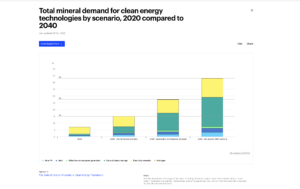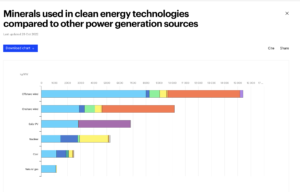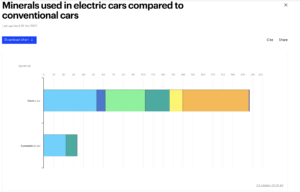Click to access TheRoleofCriticalMineralsinCleanEnergyTransitions.pdf
IEA (2021), The Role of Critical Minerals in Clean Energy Transitions, IEA, Paris
https://www.iea.org/reports/the-role-of-critical-minerals-in-clean-energy-transitions
The Role of Critical World Energy Outlook Special Report Minerals in Clean Energy Transitions
Excerpts: Solar photovoltaic (PV) plants, wind farms and electric vehicles (EVs) generally require more minerals to build than their fossil fuel-based counterparts. A typical electric car requires six times the mineral inputs of a conventional car and an onshore wind plant requires nine times more mineral resources than a gas-fired plant. Since 2010 the average amount of minerals needed for a new unit of power generation capacity has increased by 50% as the share of renewables in new investment has risen.
…
Lithium, nickel, cobalt, manganese and graphite are crucial to battery performance, longevity and energy density. Rare earth elements are essential for permanent magnets that are vital for wind turbines and EV motors. Electricity networks need a huge amount of copper and aluminium, with copper being a cornerstone for all electricity-related technologies.
The shift to a clean energy system is set to drive a huge increase in the requirements for these minerals, meaning that the energy sector is emerging as a major force in mineral markets. Until the mid-2010s, for most minerals, the energy sector represented a small part of total demand. However, as energy transitions gather pace, clean energy technologies are becoming the fastest-growing segment of demand. In a scenario that meets the Paris Agreement goals (as in the IEA Sustainable Development Scenario [SDS]), their share of total demand rises significantly over the next two decades to over 40% for copper and rare earth elements, 60-70% for nickel and cobalt, and almost 90% for lithium. EVs and battery storage have already displaced consumer electronics to become the largest consumer of lithium and are set to take over from stainless steel as the largest end user of nickel by 2040.
…
An offshore wind farm requires 13X more critical minerals than a natural gas power plant.
This doesn't include bulk materials.
1 Wind Turbine Requires:
900 tons of steel
2,500 tons of concrete
45 tons of non-recyclable plastichttps://t.co/IH6aE0EQc3 pic.twitter.com/UNmW22nbd8— Brian Gitt (@BrianGitt) January 13, 2023





